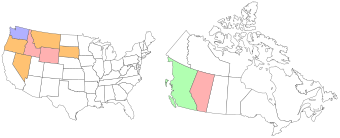rmrc51
Member
    
Posts: 1087
Freyja. Queen of the Valkyries
Palmyra, Virginia
|
 |
« on: March 13, 2012, 03:25:39 AM » |
|
I just bought some chrome racks that will be mounted on the top of the wheel wells on my trike. I have to drill 4 holes for the mounting screws on each wheel well. Now this might sound strange, but I've never drilled through fiberglass before. Needless to say,,, I "DON'T" want to screw up!!!  Are there any special drill bits that should be used for fiberglass or any special procedures?  |
|
|
|
|
 Logged
Logged
|
VRCC # 30041
|
|
|
|
quexpress
|
 |
« Reply #1 on: March 13, 2012, 05:15:43 AM » |
|
No special procedure other than watching out not to drill holes in your tires.
|
|
|
|
|
 Logged
Logged
|
I still have a full deck.
I just shuffle slower ...
|
|
|
|
Farther
|
 |
« Reply #2 on: March 13, 2012, 05:52:02 AM » |
|
I would think a brad point drill bit that is very sharp would be the way to go but I haven't drilled in fiberglass either. I know that doing precise drilling in wood works far better with brad point drill bits. Try doing a Google search for drilling in fiberglass, you might get something.
|
|
|
|
|
 Logged
Logged
|
Thanks,
~Farther
|
|
|
JC
Member
    
Posts: 321
The Beast
Franklin, TN
|
 |
« Reply #3 on: March 13, 2012, 06:16:45 AM » |
|
Just use a sharp bit, light pressure, and drill slowly like you would metal. The key is not to push so hard that you break or fracture the back side of the gelcoat. I have a vacuum going to remove the dust/glass as I drill.
|
|
|
|
|
 Logged
Logged
|
Damn thing gives me the grins every time I get on it!
|
|
|
|
dreamaker
|
 |
« Reply #4 on: March 13, 2012, 06:17:07 AM » |
|
We in the day use to resharpen some of our drills in a unconventional way and we called them sheet metal drills. First thing when we worked in a shop is to learn how to hand sharpen drills in different ways. I use this on sheet metal and some material that I am not sure of. The problem seems to be when you break through the other side with a regular sharpened drill it catches and distorts the hole quick. When we use this style, and on the other end it comes out as a little disc. like plug and it keeps the hole round. Hope this helps. I zoom in on a small drill, this is only a 1/4" drill  |
|
|
|
« Last Edit: March 13, 2012, 06:19:00 AM by dreamaker »
|
 Logged
Logged
|
|
|
|
|
Flat6Valk
|
 |
« Reply #5 on: March 13, 2012, 06:38:45 AM » |
|
I would use a tile bit. they are shaped like an arrowhead. I would think the label on the bit packaging would suggest they are good for tile, plastic,acrylic, etc.
They are not expensive.
|
|
|
|
|
 Logged
Logged
|
RIDE SAFE-RIDE OFTEN........GO BUCKEYES!!!
|
|
|
|
bobm
|
 |
« Reply #6 on: March 13, 2012, 07:27:59 AM » |
|
i would drill a small pilot hole first
|
|
|
|
|
 Logged
Logged
|
|
|
|
|
Ricky-D
|
 |
« Reply #7 on: March 13, 2012, 07:28:39 AM » |
|
Just about any kind of sharp drill will work fine.
The important thing: Attaching to fiberglass and how you accomplish it.
Sheet metal screws are about the worst permanent fastener to use in fiberglass, next to nails.
Bolts and nuts w/washers are Ok, but torquing them down can damage the fiberglass.
The best choice: Pop rivets are very good and with washer backups are excellent.
***
|
|
|
|
|
 Logged
Logged
|
2000_Valkyrie_Interstate
|
|
|
|
BigBod
|
 |
« Reply #8 on: March 13, 2012, 07:33:29 AM » |
|
Put masking tape where you are going to drill, this will stop the drill bit slipping. Mark it and drill a pilot hole first with either a 1/16" or 1/8" drill bit. For this kind of job I never use an electric drill. I always use a hand drill.
Once you've drilled the first hole, offer the rack up and bolt it through the one hole, you can then line it up and mark up the other 3 holes and know they are in the right place.
That masking tape really does make all the difference.
|
|
|
|
|
 Logged
Logged
|
|
|
|
|
Ricky-D
|
 |
« Reply #9 on: March 13, 2012, 08:11:01 AM » |
|
Yep, tape is good, and drilling fiberglass should be a carefully practiced exercise.
Where possible a backup should be used to protect against punch out.
Drilling slowly with a sharp bit is the best practice.
If you're going to use a lot of pressure, punch out can easily occur and you might as well use a nail to make the hole.
***
|
|
|
|
|
 Logged
Logged
|
2000_Valkyrie_Interstate
|
|
|
rmrc51
Member
    
Posts: 1087
Freyja. Queen of the Valkyries
Palmyra, Virginia
|
 |
« Reply #10 on: March 14, 2012, 01:38:09 AM » |
|
Thanks for all of the suggestions. Tape and going slow with minimum pressure will definitely be followed!  |
|
|
|
|
 Logged
Logged
|
VRCC # 30041
|
|
|
|
Gideon
|
 |
« Reply #11 on: March 14, 2012, 03:43:18 PM » |
|
I also have a trike. I would appreciate seeing photos after you complete the project.  God bless |
|
|
|
|
 Logged
Logged
|
But they that wait upon the Lord shall renew their strength; they shall mount up with wings as eagles; they shall run and not be weary; they shall walk, and not faint. Isaiah 40:31
|
|
|
gordonv
Member
    
Posts: 5766
VRCC # 31419
Richmond BC
|
 |
« Reply #12 on: March 14, 2012, 07:45:15 PM » |
|
From watching all those boating shows, besides the masking tape, always ream the hole afterwards, to stop spider scracks from starting. It doesn't have to be deep, just cut that sharp edge off the hole.
|
|
|
|
|
 Logged
Logged
|
1999 Black with custom paint IS   |
|
|
rmrc51
Member
    
Posts: 1087
Freyja. Queen of the Valkyries
Palmyra, Virginia
|
 |
« Reply #13 on: March 15, 2012, 07:12:05 AM » |
|
From watching all those boating shows, besides the masking tape, always ream the hole afterwards, to stop spider scracks from starting. It doesn't have to be deep, just cut that sharp edge off the hole.
Thanks for the additional tip. The 'LAST' thing I want or need are cracks forming afterwards!!! |
|
|
|
|
 Logged
Logged
|
VRCC # 30041
|
|
|
rmrc51
Member
    
Posts: 1087
Freyja. Queen of the Valkyries
Palmyra, Virginia
|
 |
« Reply #14 on: March 15, 2012, 07:13:01 AM » |
|
I also have a trike. I would appreciate seeing photos after you complete the project.  God bless I plan on installing the racks this weekend. I'll post pictures afterwards.  |
|
|
|
|
 Logged
Logged
|
VRCC # 30041
|
|
|
|
Rio Wil
|
 |
« Reply #15 on: March 15, 2012, 09:04:03 AM » |
|
Use a regular drill bit and run the drill BACKWARDS.... with light pressure
|
|
|
|
|
 Logged
Logged
|
|
|
|
|
shortleg
|
 |
« Reply #16 on: March 15, 2012, 02:44:59 PM » |
|
Back when I had a Vett we would use a smaller sharp bit first.
Then the larger one.
A good idea would be to use a strap of metal on the onderside
and ron your bolts through the rack, fende then through the metal strap.
That will thak the pressure off the fiberglall and spread out the load.
Shortleg[Dave]
|
|
|
|
|
 Logged
Logged
|
|
|
|
|
RP#62
|
 |
« Reply #17 on: March 15, 2012, 06:07:09 PM » |
|
I asked my son, who used to work for a boat manufacturer and he said they used regular drills, they just made sure they were sharp and he said they used very light pressure. He said if you use too much pressure, it'll shred the back side worse than drilling plywood.
-RP
|
|
|
|
|
 Logged
Logged
|
|
|
|
wiggydotcom
Member
    
Posts: 3387
Do Your Best and Miss the Rest!
Yorkville, Illinois
|
 |
« Reply #18 on: March 15, 2012, 07:19:55 PM » |
|
From watching all those boating shows, besides the masking tape, always ream the hole afterwards, to stop spider scracks from starting. It doesn't have to be deep, just cut that sharp edge off the hole.
gordon, I'm not trying to get nitpicky, but I don't see how a reamer could get rid of any sharp edges. Did you possibly mean put a slight chamfer on the hole afterwards? |
|
|
|
|
 Logged
Logged
|
VRCC #10177 VRCCDS #239  |
|
|
gordonv
Member
    
Posts: 5766
VRCC # 31419
Richmond BC
|
 |
« Reply #19 on: March 15, 2012, 09:08:07 PM » |
|
Yes, that is the correct word. It's been a while. I used to have a reamer, which would but that chamfer on the hole.
|
|
|
|
|
 Logged
Logged
|
1999 Black with custom paint IS   |
|
|
wiggydotcom
Member
    
Posts: 3387
Do Your Best and Miss the Rest!
Yorkville, Illinois
|
 |
« Reply #20 on: March 16, 2012, 06:13:00 AM » |
|
Yes, that is the correct word. It's been a while. I used to have a reamer, which would but that chamfer on the hole.
Ok, thanks..that's good advice. I'm going to mount my fender extensions after I get caught up on a few chores. I'll certainly do the small chamfer. The weather has been awesome in Illinois the last few days. It's hard to want to put the bike down for chrome installs when I can be riding.  |
|
|
|
|
 Logged
Logged
|
VRCC #10177 VRCCDS #239  |
|
|
|
Farther
|
 |
« Reply #21 on: March 16, 2012, 09:06:57 AM » |
|
Brad point drill bit, the largest fender washers available for your application and nylock nuts is what I would use. If the surface is curved you can alway pre-shape the fender washers to the curve of the surface.
|
|
|
|
|
 Logged
Logged
|
Thanks,
~Farther
|
|
|
|

